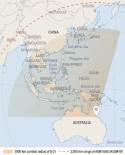This rumor contradicts everything we know. Shilao&co had remarked in their podcast that:
1. The national priority for the PLAAF is to become a strategic airforce. Strategic airforce explicitly means nuclear capable bombers.
2. The PLA developed a nuclear ALBM for the H-6N just so the PLAAF can practice nuclear missions in preparation for the H-20.
3. The H-20 program at this stage has cost more than the J-20 program at the equivalent stage in terms of years into development.
A delay is possible but cancellation is absurd.
Well I never said that H-20 is cancelled, what I'm saying is that in the near term, they may be pursuing an alternative solution for the "fixed wing long range penetrating strike bomber" mission rather than a large manned stealthy aircraft.
Everything said here can apply to high end destroyers (and even more so aircraft carriers). Yet, China is producing more 055/052Ds and not drone 056/022s.
Not quite -- high end destroyers offer certain capabilities that cannot be offered by smaller ships, including large and powerful radars, being able to operate beyond green water, large VLS capacity, and those are missions which are relevant for a high end western pacific/central pacific fight which cannot be fulfilled with other platforms (albeit we are likely to see LUSVs with VLS to augment this capability).
To me, the equivalent of H-20 (i.e.: large, expensive, likely to be procured in limited numbers and being presently inappropriate for the PLA's geostrategic situation) is aircraft carriers. Aircraft carriers hold a vital and unique role of course, but we see how the PLAN are not immediately moving into producing more carriers and are taking a measured approach, and I suspect part of that is because they recognize the geostrategic positioning is not favourable at the moment for carriers.
I see H-20 and carriers as similar in that way -- there will always be a mission and requirement for them, but the issue for us is whether it makes sense for them to procure them for the near term in the next 5-6 years for example.
Given that a S/IRBM have a flight time of mere minutes, I don't think "unmolested and un-degraded IADS" can exist on the American side in any war scenario. Unless you are suggesting a Pearl Harbor-style sneak attack in which case by definition the alertness of the defense would be relatively minimal.
I don't see what a flight time of mere minutes has to do with anything. It isn't flight time which is important but rather the capability and positioning of the defenses and sensors as part of the IADS, and it should absolutely be assumed as a given that US defenses against SRBMs, IRBMs and HGVs will become more potent in the region compared to today.
A 2IC-ranged bomber does not make sense given how few targets there are in Guam. For a long range bomber, China should be aiming for an unfueled range reaching Hawaii and Australia, with refueled range to reach CONUS. See rough diagram below
View attachment 131011
A two tiered force made up of GJ-11 and H-20 is ideal.
A 2IC ranged bomber matters because Guam is and will remain a linchpin for US air and sea power in the western pacific outside of the 1IC, and PLA fires bandwidth and re-attack capability against a reinforced Guam at present and into the future will be limited. Furthermore, there are other smaller islands in the approximate 2IC distance range which the US is aiming to build up as smaller bases for air power. Finally being able to robustly project fires into 2IC distances means the ability to threaten US naval forces operating in that region more effectively, further reducing US air and sea power ability to be projected into the 1IC esque region.
The idea of wanting an unrefuelled range for Hawaii and Australia is understandable, but it requires the PLA to first be able to robustly and thoroughly strike and neutralize 2IC targets first (Guam, US naval forces), and that is something they cannot yet do.

